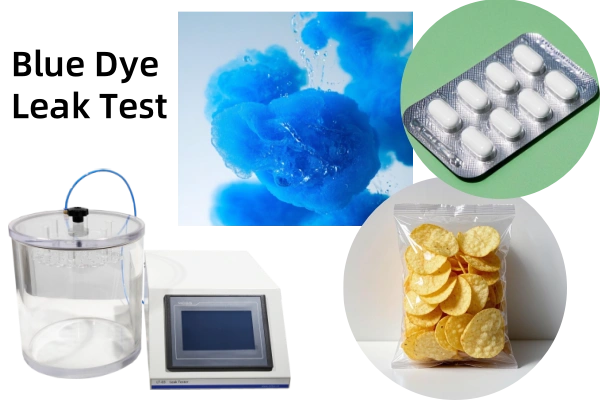Why Methylene Blue is Used for Leak Test
Methylene blue, a synthetic dye with a vibrant blue color, has become the go-to choice for test d'étanchéité due to its unique properties:
- High Visibility: The intense blue color makes even the smallest leaks easily detectable.
- Water Solubility: It dissolves readily in water, allowing for easy preparation of test solutions.
- Non-Toxic Nature: Methylene blue is safe to use in most applications, including food and medical packaging.
- Chemical Stability: It remains stable under a wide range of temperatures and pH levels, ensuring consistent results.
Compared to other dyes and methods, methylene blue offers a balance of affordability, precision, and ease of use, making it a preferred option for industries requiring rigorous leak testing.
Introduction to Leak Detection in Packaging
Leak detection is a critical aspect of quality assurance in industries ranging from pharmaceuticals to food packaging. Even the smallest leak can compromise product integrity, leading to contamination, spoilage, or safety hazards. To ensure airtight seals and packaging integrity, various leak detection methods are employed. Among these, the methylene blue leak test stands out as a reliable, cost-effective, and widely used solution.
Blue Dye Packaging Testing: Principles and Applications
Blue dye packaging testing is a straightforward yet effective method for identifying leaks in sealed containers, pouches, and other packaging formats. The principle is simple: a blue dye solution is applied to the exterior of the packaging, and any leaks will draw the dye into the package, revealing the defect.
This method is widely used in:
- Dispositifs médicaux: Ensuring sterile packaging for syringes, catheters, and implants.
- Alimentation et boissons: Verifying the integrity of sealed containers to prevent contamination.
- Automobile: Testing fluid reservoirs and other sealed components.
The versatility of blue dye testing makes it a staple in quality control processes across industries.
Step-by-Step Blue Dye Leak Test Method
Conducting a methylene blue leak test is a straightforward process. Here’s a step-by-step guide:
- Prepare the Test Solution:
- Dissolve methylene blue powder in water to create a concentrated solution. The concentration can vary depending on the sensitivity required.
- Apply the Solution:
- Submerge the packaging or apply the solution to the suspected areas (e.g., seals, joints).
- Allow Time for Penetration:
- Let the solution sit for a specified period, allowing it to penetrate any potential leaks.
- Inspect for Leaks:
- Open the packaging and inspect for the presence of blue dye inside. Any traces of dye indicate a leak.
- Document Results:
- Record the findings and take corrective actions if leaks are detected.
This method is highly effective for identifying even microscopic leaks, ensuring the highest standards of packaging integrity.
Advantages of the Methylene Blue Leak Test
The methylene blue leak test offers several advantages:
- Cost-Effectiveness: The dye is inexpensive, and the test requires minimal equipment.
- Haute sensibilité: It can detect leaks as small as a few microns.
- Versatilité: Suitable for a wide range of materials, including plastics, glass, and metals.
- Facilité d'utilisation: No specialized training is required to perform the test.
Case studies have demonstrated its effectiveness in industries like pharmaceuticals, where even the smallest leak can compromise product sterility.
Limitations and Considerations
While the methylene blue leak test is highly effective, it does have some limitations:
- Residue Cleanup: The dye can leave stains, requiring thorough cleaning after testing.
- Sensitivity Thresholds: Extremely small leaks may require more sensitive methods, such as helium leak testing.
- Material Compatibility: Some materials may absorb the dye, leading to false positives.
To ensure accurate results, it’s essential to follow best practices, such as using the correct dye concentration and allowing adequate penetration time.
Future Trends in Leak Detection Technology
As technology advances, new methods are emerging to complement traditional dye-based testing. These include:
- Automated Leak Detection Systems: Using sensors and AI to identify leaks with greater precision.
- Digital Imaging: High-resolution cameras and software to detect dye penetration.
- Alternative Dyes: Development of eco-friendly and more sensitive dyes for specialized applications.
Despite these innovations, methylene blue remains a trusted and widely used method due to its simplicity and reliability.
The methylene blue leak test is a proven, cost-effective, and versatile method for ensuring packaging integrity. Its high visibility, ease of use, and compatibility with various materials make it an indispensable tool in quality assurance. As industries continue to prioritize product safety and quality, the methylene blue leak test will remain a cornerstone of leak detection methodologies.
By understanding why methylene blue is used for leak tests and mastering the blue dye leak test method, businesses can ensure their products meet the highest standards of quality and safety.


